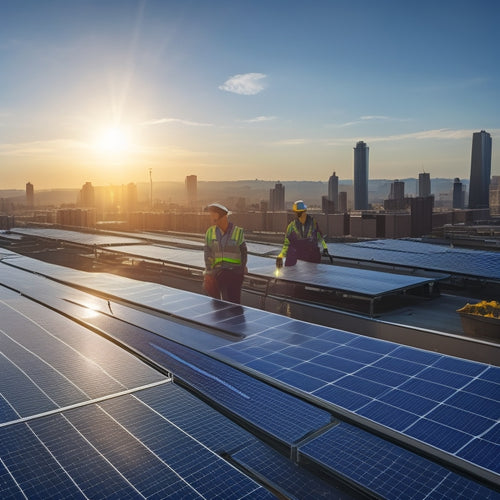
What Are the Main Expenses in Solar Electric System Cost
Share
Your solar electric system cost is comprised of several key components, with equipment costs, including high-efficiency solar panels and inverters, accounting for approximately 60% of the total expenditure. You'll also need to evaluate installation labor expenses, which vary depending on system complexity, location, and labor market. Permitting and inspection fees, mounting and tracking systems, and monitoring and maintenance costs also factor into the overall cost. Understanding these components and their relative costs will help you plan and budget for your solar electric system. As you investigate your options, you'll find the importance of each aspect and how they impact your system's performance and bottom line.
Key Takeaways
- Equipment costs, including solar panels, inverters, and mounting hardware, account for approximately 60% of total solar system expenditure.
- Installation labor expenses, including electrician, roofer, and project manager costs, vary by system complexity, location, and labor market.
- Permitting and inspection fees, which vary by jurisdiction, can add 2-5% to total system cost, ranging from a few hundred to several thousand dollars.
- Mounting and tracking systems, including roof-mounted, ground-mounted, and pole-mounted options, represent about 10-15% of total system cost.
- Ongoing monitoring and maintenance costs, including performance tracking and routine maintenance, are essential for peak system performance and can range from $100 to $500 annually.
Equipment Costs Breakdown
Your solar electric system's equipment costs comprise the largest portion of the overall expenditure, accounting for approximately 60% of the total system cost.
The primary components that make up this expense are solar panels, inverters, mounting hardware, and electrical connections.
When selecting solar panel types, you'll find that monocrystalline and polycrystalline panels vary in price. Monocrystalline panels, with higher efficiencies, are more expensive than polycrystalline panels.
You'll need to balance panel efficiency with your budget.
Inverter efficiency is another vital element to take into account. String inverters, microinverters, and power optimizers all have different efficiency ratings, affecting the overall system performance.
Higher-efficiency inverters typically come at a higher cost.
Additionally, the type and quality of mounting hardware, such as tracking systems or fixed-tilt mounts, also impact equipment costs.
Electrical connections, including cables, connectors, and wiring, complete the equipment cost breakdown.
Installation Labor Expenses
The installation labor expenses of a solar electric system encompass the cost of hiring and paying a team of skilled professionals to assemble and integrate the equipment. This cost varies depending on the complexity of the system, the location, and the labor market. You'll need to evaluate the wages analysis for electricians, roofers, and other specialists required for the installation.
| Labor Category | Estimated Cost Range |
|---|---|
| Electrician | $2,000 - $5,000 |
| Roofer | $1,500 - $3,000 |
| Project Manager | $1,000 - $2,000 |
When calculating installation labor expenses, you should also factor in the cost of peripheral tasks, such as site preparation, equipment transportation, and quality control. These costs can add up quickly, so it's crucial to get quotes from multiple contractors to verify you're getting the best deal. Additionally, be sure to check the contractor's credentials, licenses, and insurance to guarantee a safe and successful installation. By understanding the installation labor expenses, you can better plan your solar electric system project and achieve your goal of utilizing renewable energy.
Permitting and Inspection Fees
Beyond labor expenses, you'll need to factor in permitting and inspection fees, which can add a significant amount to your overall solar electric system cost.
These fees vary by jurisdiction, but typically include charges for plan review, permit issuance, and inspections. The permitting process involves submitting your system design and installation plans to local authorities, who review them to guarantee compliance with relevant building codes and electrical standards.
You'll need to pay for inspections at various stages of the installation process, including a final inspection to verify that your system meets local inspection standards.
These fees can range from a few hundred to several thousand dollars, depending on the complexity of your system and the jurisdiction in which you're installing it.
Be certain to factor these costs into your overall budget to avoid surprises down the line. On average, permitting and inspection fees can add 2-5% to your total system cost.
Mounting and Tracking Systems
Mounting and tracking systems are an essential component of your solar electric system, and typically account for around 10-15% of the total system cost.
These systems guarantee that your solar panels are securely fastened to your roof or ground, and are positioned at the ideal angle to capture the maximum amount of sunlight.
When it comes to mounting techniques, you have several options to choose from, including:
-
Roof-mounted systems: These are the most common type, where panels are attached directly to your roof.
-
Ground-mounted systems: These involve installing panels on the ground, often using a tracking system to follow the sun's movement.
-
Pole-mounted systems: These combine the benefits of roof and ground-mounted systems, offering greater flexibility.
- Tracking systems: These advanced technologies adjust the angle and orientation of your panels to maximize energy output throughout the day.
Monitoring and Maintenance Costs
Regularly, you'll need to set aside a budget for monitoring and maintaining your solar electric system to confirm it operates at peak performance.
Performance monitoring is vital to identify any potential issues or faults in the system. This includes tracking the system's energy output, voltage, and current to ascertain it's meeting the expected standards. You'll need to invest in monitoring software or hardware that provides real-time data to help you detect any anomalies.
Routine maintenance is also important to prevent system failures and reduce downtime. This includes cleaning the panels, inspecting the wiring and connections, and replacing components as needed.
You may need to hire a professional to perform these tasks, especially if you're not familiar with the system's inner workings. The cost of maintenance will depend on the frequency of services, the size of the system, and the location.
On average, you can expect to pay between $100 to $500 per year for maintenance, depending on the complexity of the system.
Frequently Asked Questions
Can I Install a Solar Electric System Myself to Save Money?
You can attempt a DIY installation to reduce costs, but beware: improper installation can lead to safety hazards, reduced efficiency, and even void your warranty, offsetting potential cost savings.
How Long Does a Typical Solar Electric System Last?
You can expect a typical solar electric system to last around 25-30 years, with a solar panel lifespan of 30-40 years, provided you perform regular system maintenance, such as cleaning and inspecting the panels, to guarantee peak performance.
Can Solar Electric Systems Work During Power Outages?
When the grid goes down, you can rely on your solar electric system to keep powering your home, but only if you've invested in solar battery storage and a grid connection that allows islanding, enabling your system to disconnect from the grid and operate independently.
Are There Any Government Incentives for Solar Electric Systems?
You're literally swimming in savings! As you invest in solar electric systems, you'll plunge into a sea of government incentives, including federal tax credits of up to 30% of the total cost, driving the renewable energy revolution forward!
Can I Finance a Solar Electric System Through a Loan?
You can finance a solar electric system through a loan, exploring various solar loans and financing options, such as home equity loans, personal loans, or solar-specific financing programs, to cover the upfront costs and start utilizing renewable energy.
Conclusion
As you commence on your solar electric system expedition, remember that every penny counts. Like Achilles' heel, a single misstep in calculating costs can be your downfall. Don't let hidden expenses catch you off guard. By understanding the main expenses involved, from equipment costs to monitoring and maintenance, you'll be well-equipped to traverse the complex terrain of solar electric system costs, emerging victorious like Alexander the Great conquering new territories.
Related Posts
-

Off-Grid Solar Solutions for Sustainable Farming
Off-grid solar solutions can revolutionize your farming operations by providing energy independence and significant c...
-

Solar Installation Guide for Commercial Properties
Implementing solar energy solutions in your commercial property can lead to significant long-term savings and sustain...
-

How to Reduce Home Energy Bills
To reduce your home energy bills, start by investing in energy-efficient appliances and upgrading your insulation. Lo...


